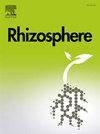Bacillus-derived cyclic lipopeptides modulate microbiome structure and enzymatic activity of soil and increase productivity of potato (Solanum tuberosum L.)
IF 3.5
3区 生物学
Q1 PLANT SCIENCES
引用次数: 0
Abstract
Cyclic lipopeptides (CLPs) are well-known secondary metabolites produced by Bacillus bacteria. Current research into the role of lipopeptides in soil microbial ecology suggests that their importance goes beyond the suppression of phytopathogens. Here we studied CLPs (bacillomycins and fengycins) as potential modulators of the structural (taxonomic) and functional (enzymatic activity) properties of the microbiome in agroecosystems with the aim of improving soil health and, consequently, plant productivity. The metabolic activity of the soil microbial communities has been found to be stimulated by the application of CLPs to soil. Microbial enzymes involved in the cycling of carbon (3 enzymes), nitrogen (2 enzymes) and phosphorus (1 enzyme) were activated in an experimental condition. Exposure to CLPs did not alter the alpha diversity of bacteria, but increased the alpha diversity of fungi. Amplicon sequencing showed that the action of CLPs alters the taxonomicstructure of bacterial and fungal communities. The constructed network of relationships between enzyme activity and changes in the microbial community allows us to identify potential taxa of bacteria and fungi that determine the activity of specific enzymes. The proposed mechanism behind changes in soil functional activity involves a change in the abundance of specific groups of bacteria and fungi, which gaine a competitive advantage after the introduction of CLPs into the soil. Finally, we tested the CLPs-based preparation on potato tubers and found that it improved the physiological parameters of the plants. Thus, the use of purified Bacillus-derived CLPs allowed better characterization of the biological effects exerted by soil bacilli on the soil microbiome. Bacillus CLPs are found to be non-toxic and to stimulate soil microbiota.
芽孢杆菌衍生的环脂肽调节土壤微生物群结构和酶活性,提高马铃薯产量
环状脂肽(CLPs)是众所周知的由芽孢杆菌产生的次生代谢产物。目前对脂肽在土壤微生物生态中的作用的研究表明,它们的重要性超出了抑制植物病原体。在这里,我们研究了CLPs (bacillomycin和fengycins)作为农业生态系统中微生物组结构(分类)和功能(酶活性)特性的潜在调节剂,目的是改善土壤健康,从而提高植物生产力。土壤微生物群落的代谢活性已被发现被施用于土壤的CLPs刺激。在实验条件下,激活参与碳(3酶)、氮(2酶)和磷(1酶)循环的微生物酶。暴露于CLPs没有改变细菌的α多样性,但增加了真菌的α多样性。扩增子测序显示,CLPs的作用改变了细菌和真菌群落的分类结构。构建的酶活性与微生物群落变化之间的关系网络使我们能够确定决定特定酶活性的细菌和真菌的潜在分类群。土壤功能活性变化背后的机制涉及特定细菌和真菌群丰度的变化,这些细菌和真菌在将CLPs引入土壤后获得竞争优势。最后,我们在马铃薯块茎上测试了基于clps的制剂,发现它改善了植株的生理参数。因此,使用纯化的芽孢杆菌衍生的CLPs可以更好地表征土壤芽孢杆菌对土壤微生物组的生物学效应。发现CLPs芽孢杆菌是无毒的,并能刺激土壤微生物群。
本文章由计算机程序翻译,如有差异,请以英文原文为准。
求助全文
约1分钟内获得全文
求助全文
来源期刊

Rhizosphere
Agricultural and Biological Sciences-Agronomy and Crop Science
CiteScore
5.70
自引率
8.10%
发文量
155
审稿时长
29 days
期刊介绍:
Rhizosphere aims to advance the frontier of our understanding of plant-soil interactions. Rhizosphere is a multidisciplinary journal that publishes research on the interactions between plant roots, soil organisms, nutrients, and water. Except carbon fixation by photosynthesis, plants obtain all other elements primarily from soil through roots.
We are beginning to understand how communications at the rhizosphere, with soil organisms and other plant species, affect root exudates and nutrient uptake. This rapidly evolving subject utilizes molecular biology and genomic tools, food web or community structure manipulations, high performance liquid chromatography, isotopic analysis, diverse spectroscopic analytics, tomography and other microscopy, complex statistical and modeling tools.
 求助内容:
求助内容: 应助结果提醒方式:
应助结果提醒方式:


